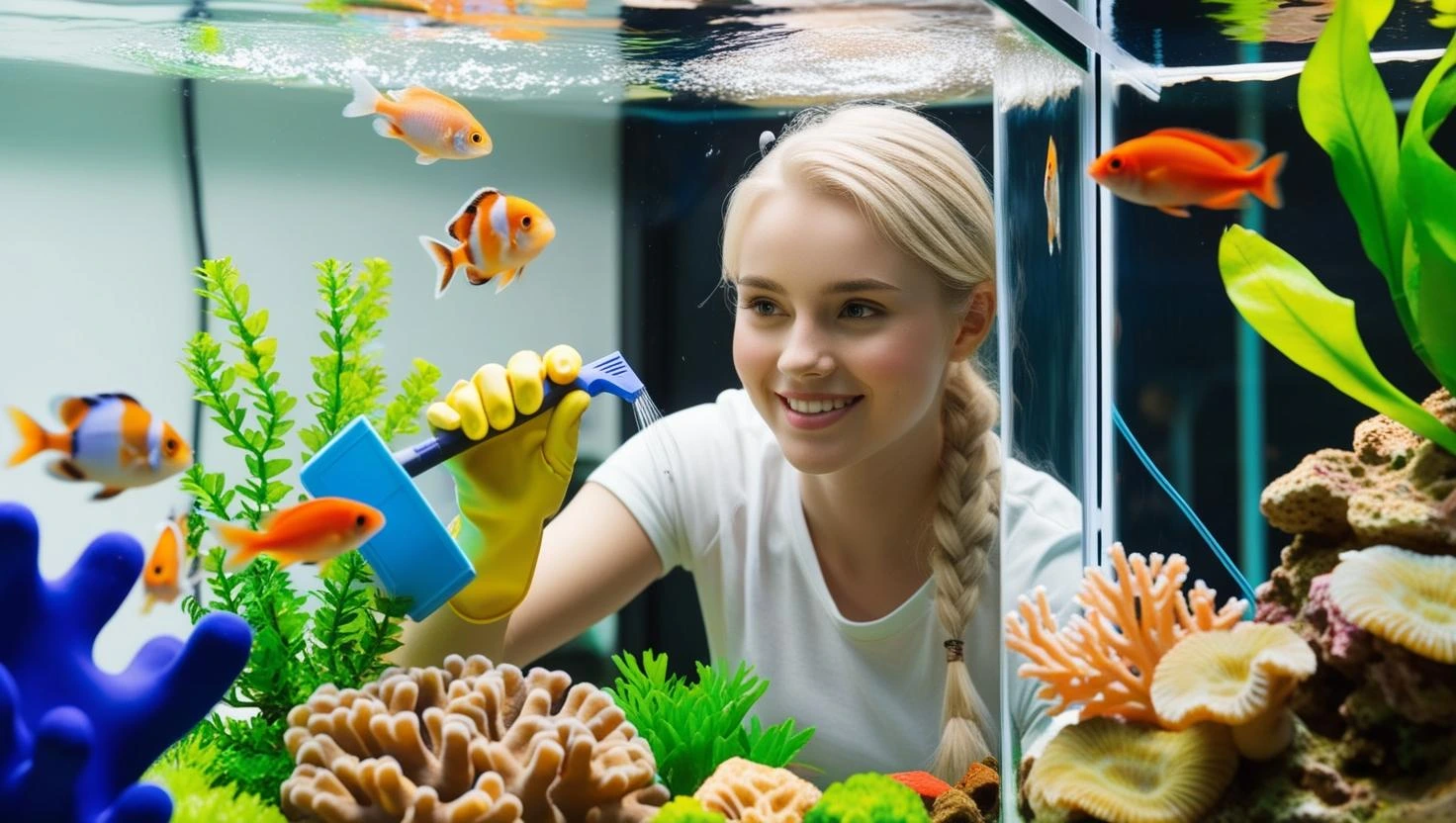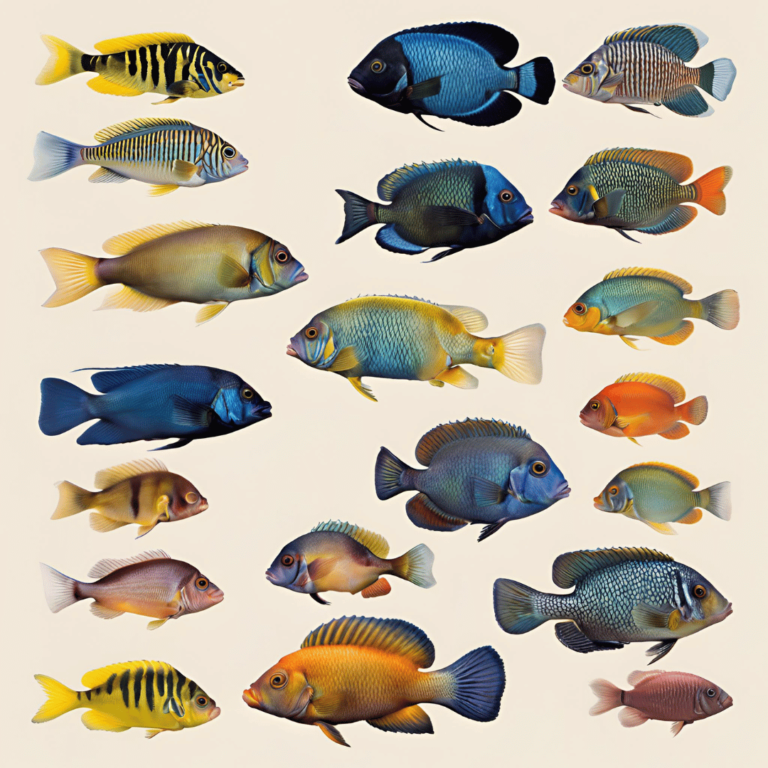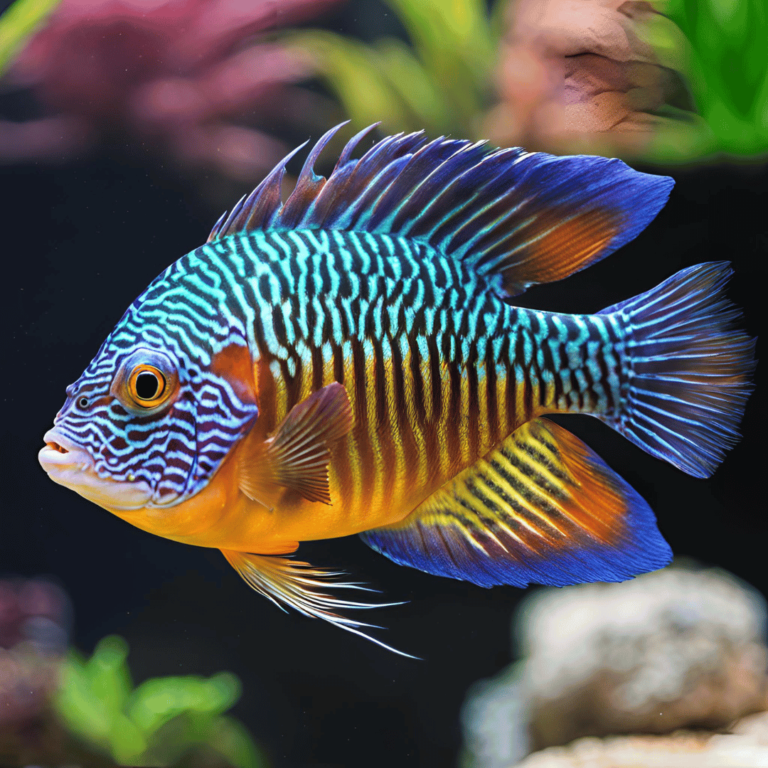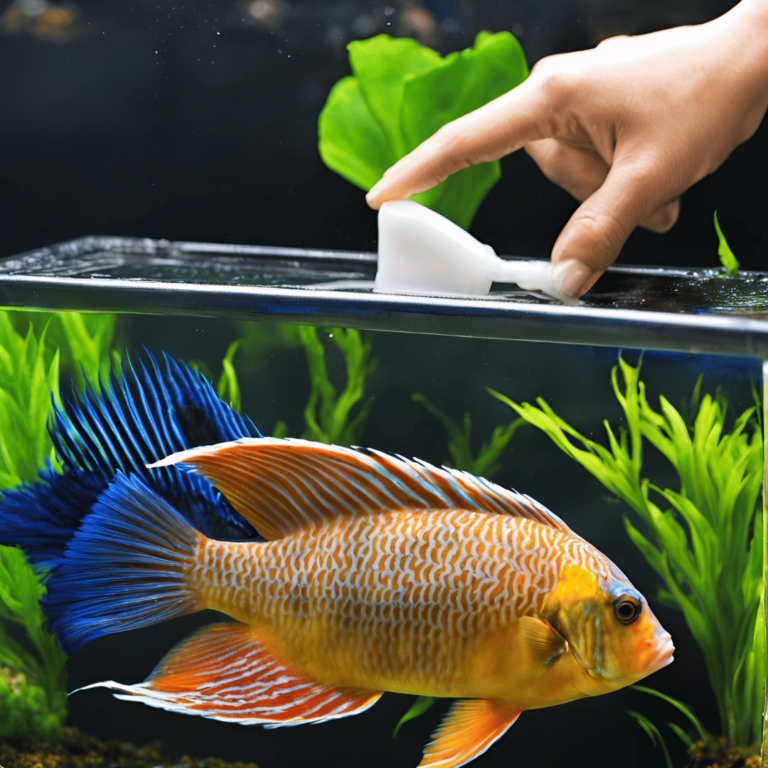Your trusted guide to cichlid care, tank setups, and quality products.

8 Step Guide to Routine Peacock Cichlid Tank Cleaning Tips!
Image Credits Canva
Maintaining a pristine aquarium is key to ensuring the vibrant colors and overall health of your peacock cichlids. In this comprehensive guide, we break down the process of Peacock Cichlid Tank Cleaning into eight clear, actionable steps that will help you create a healthy, thriving environment for your aquatic pets. By following these steps, you’ll not only enhance the beauty of your tank but also prevent common issues such as algae build-up and toxic water conditions.
Why Peacock Cichlid Tank Cleaning is Essential
Regular Peacock Cichlid Tank Cleaning is more than just a chore, it’s a vital part of keeping your aquarium healthy and visually appealing. Here’s why:
- Health Benefits: Routine cleaning removes harmful toxins like ammonia and nitrites, which can cause stress and disease in your peacock cichlids. Clean water promotes a robust immune system and vibrant coloration.
- Environmental Stability: Consistent Peacock Cichlid Tank Cleaning helps maintain balanced water parameters. By eliminating debris and waste, you create a stable environment that supports both fish and beneficial bacteria.
- Aesthetic Appeal: A clean tank not only looks stunning but also gives you a clear view of your beautifully colored peacock cichlids. Removing algae and debris from glass and decorations enhances the overall visual appeal.
By integrating Peacock Cichlid Tank Cleaning into your regular maintenance routine, you ensure that your fish live in a toxin-free, comfortable habitat, which is essential for their longevity and happiness.
Essential Tools & Supplies for Peacock Cichlid Tank Cleaning
Before diving into the cleaning process, it’s important to gather all the necessary supplies. Here’s what you’ll need for effective Peacock Cichlid Tank Cleaning:
- Algae Scrubbers or Magnetic Cleaners: Ideal for removing stubborn algae from the glass without scratching the surface.
- Siphon Vacuum: Perfect for cleaning the substrate by removing debris, uneaten food, and waste while preserving beneficial bacteria.
- Buckets: Use dedicated buckets for removing and adding water. Make sure these are reserved only for aquarium use to avoid contamination.
- Water Conditioners: Essential for neutralizing chlorine, chloramines, and heavy metals in tap water before refilling the tank.
- Soft Brushes: Great for gently scrubbing decorations and artificial plants to remove algae and buildup.
Having these tools at your disposal makes Peacock Cichlid Tank Cleaning efficient and ensures that every aspect of your aquarium is maintained properly.
Step 1: Prepare Your Cleaning Station
A well-organized cleaning station is the foundation of effective Peacock Cichlid Tank Cleaning. Follow these steps to set up your space:
- Select a Safe Workspace: Choose an area where you can work comfortably without the risk of water splashes near electrical outlets.
- Gather All Supplies: Lay out your siphon, algae scraper, brushes, buckets, and water conditioner. This ensures a smooth process without having to stop and search for tools.
- Review Manufacturer Instructions: Whether you’re using a siphon vacuum or an algae scraper, read the instructions first to avoid any mishaps.
- Safety First: Unplug any electrical equipment such as heaters, filters, and lights before you start cleaning. This precaution is a critical part of safe Peacock Cichlid Tank Cleaning.
Setting up a dedicated cleaning station makes the entire Peacock Cichlid Tank Cleaning process more efficient and minimizes the risk of accidents.
Step 2: Secure Your Peacock Cichlids & Unplug Equipment
Before starting the cleaning process, it’s important to ensure the safety of your fish and the proper handling of your equipment:
- Transfer Your Fish: Gently use a soft net to move your peacock cichlids into a temporary holding container. Use water from the tank to maintain familiar conditions and reduce stress.
- Unplug Electrical Equipment: Disconnect filters, heaters, and lights to prevent any water-related hazards. This is a crucial step in Peacock Cichlid Tank Cleaning, ensuring that no electrical accidents occur.
These precautions guarantee that your peacock cichlids remain safe and stress-free while you perform your routine Peacock Cichlid Tank Cleaning.
Step 3: Remove & Clean Decorations and Plants
Decorations and plants in your aquarium can harbor algae and debris, making their cleaning an essential part of Peacock Cichlid Tank Cleaning:
- Carefully Remove Items: Take out all rocks, ornaments, and artificial plants. If you have live plants, follow their specific care instructions to avoid damage.
- Scrub Gently: Use a soft brush to remove algae and debris. Rinse the items thoroughly with water from the tank to avoid introducing harmful chemicals.
- Inspect for Damage: As you clean, check for any signs of wear or deterioration that could affect the safety of your aquarium.
Regularly cleaning these items is key to successful Peacock Cichlid Tank Cleaning, ensuring both aesthetic appeal and a healthy environment for your fish.
Step 4: Siphon Cleaning of the Substrate
The substrate, whether gravel or sand, accumulates debris, uneaten food, and fish waste. Here’s how to incorporate siphon cleaning into your Peacock Cichlid Tank Cleaning routine:
- Set Up Your Siphon: Submerge the siphon in your tank and start the water flow by gently sucking on the end (if using a manual siphon) until the water flows steadily.
- Clean the Substrate: Slowly move the siphon across the substrate to remove debris. Focus on areas with visible waste but avoid disturbing the beneficial bacteria that help keep your tank healthy.
- Control the Water Change: Aim to remove about 25–30% of the tank water during each cleaning session. This controlled water change is an essential part of Peacock Cichlid Tank Cleaning and helps maintain water quality.
A thorough siphon cleaning is a cornerstone of effective Peacock Cichlid Tank Cleaning, ensuring that the substrate remains clean without compromising the ecosystem.
Step 5: Clean the Glass & Remove Algae
Clear glass is crucial for showcasing the beauty of your aquarium. Here’s how to ensure your glass stays clean as part of your Peacock Cichlid Tank Cleaning routine:
- Choose the Right Tool: Use an algae scraper or magnetic cleaner specifically designed for aquarium glass. These tools are effective and safe for glass surfaces.
- Scrub the Glass: Use smooth, overlapping strokes to remove algae and buildup from the glass. Pay extra attention to corners and edges where algae tends to accumulate.
- Rinse the Tool as Needed: If you’re using an algae scraper, rinse it periodically to remove accumulated algae. This maintains its effectiveness throughout the cleaning process.
Regular glass cleaning is an integral element of Peacock Cichlid Tank Cleaning, as it not only enhances visibility but also contributes to a healthier environment by reducing potential algae-related issues.
Step 6: Rinse and Clean Equipment
In addition to cleaning the tank itself, maintaining your equipment is crucial for overall Peacock Cichlid Tank Cleaning:
- Clean Filters Carefully: Rinse filter components using water from the tank, not tap water to preserve the beneficial bacteria that are essential for water quality.
- Wipe Down Heaters and Lights: Use a damp cloth to clean these items, ensuring no harmful chemicals are introduced.
- Inspect Equipment: Regularly check the condition of all equipment. Replace any worn or malfunctioning parts to maintain a stable environment for your fish.
By integrating equipment maintenance into your Peacock Cichlid Tank Cleaning routine, you ensure that every component of your aquarium system is working efficiently and safely.
Step 7: Refill the Tank with Conditioned Water
After cleaning, it’s time to restore your tank with fresh, conditioned water:
- Prepare the Water: Fill a clean bucket with tap water and add a water conditioner to neutralize chlorine, chloramines, and heavy metals. This step is critical for safe Peacock Cichlid Tank Cleaning.
- Match the Temperature: Ensure that the new water is at the same temperature as the tank water to prevent shocking your fish.
- Slowly Refill the Tank: Gently pour the conditioned water into the tank, avoiding any disruption to the cleaned substrate or decorations.
A proper refill with conditioned water is an essential step in Peacock Cichlid Tank Cleaning, ensuring that your fish return to a balanced, safe environment.
Step 8: Monitor the Tank & Reintroduce Your Peacock Cichlids
The final step in your Peacock Cichlid Tank Cleaning routine is to ensure everything is stable before reintroducing your fish:
- Test Water Parameters: Use a reliable aquarium water testing kit to check pH, ammonia, nitrite, and nitrate levels. Ensuring that these parameters are within safe limits is a crucial part of Peacock Cichlid Tank Cleaning.
- Gradually Reintroduce Your Fish: Once the water quality is confirmed to be stable, slowly reintroduce your peacock cichlids back into the tank. Float the temporary container in the tank to help equalize the temperature before releasing the fish.
- Observe for Stress: Keep a close eye on your peacock cichlids for the first few hours after reintroduction. Look for any signs of stress or abnormal behavior, which might indicate issues with water quality.
Monitoring your tank after Peacock Cichlid Tank Cleaning is the final step in ensuring that your cleaning efforts have created a safe and healthy environment for your fish.
Additional Tips for Long-Term Peacock Cichlid Tank Cleaning Success
To keep your aquarium in optimal condition, consider these extra maintenance tips:
- Stick to a Regular Schedule: Establish a routine cleaning schedule, whether weekly or bi-weekly to prevent major issues from developing. Consistent Peacock Cichlid Tank Cleaning makes maintenance more manageable.
- Frequent Water Testing: Regularly test your water parameters to catch any deviations early. This proactive approach is a key component of effective Peacock Cichlid Tank Cleaning.
- Seasonal Deep Cleans: In addition to routine maintenance, perform a more thorough cleaning every few months to address any buildup that regular cleaning might miss.
- Stay Informed: Read up on the latest tips and techniques for Peacock Cichlid Tank Cleaning to continually improve your maintenance routine.
Implementing these long-term strategies will help ensure that your aquarium remains a vibrant, healthy environment for your peacock cichlids.
Conclusion
Regular Peacock Cichlid Tank Cleaning is essential for the health, beauty, and longevity of your aquarium. By following these eight comprehensive steps, from setting up your cleaning station and securing your fish to meticulously cleaning the substrate, glass, and equipment, you’re ensuring that your peacock cichlids thrive in a clean, toxin-free environment. This routine not only improves water quality but also reduces stress and supports the natural beauty of your aquatic pets.
Thank you for reading! Be sure to visit peacockcichlid.com for more expert advice and updates. Follow us on social media for the latest tips and inspiration to keep your aquarium thriving. Happy cleaning and until next time, keep those tanks sparkling!
Looking for more insights on perfecting your aquarium setup and care? Check out our other expert guides like Peacock Cichlid Tank Maintenance: 14 Proven Tips for Success and Peacock Cichlid Tank Cleaning: 7 Best Tools & Expert Tips for even more hands-on advice. You might also enjoy reading 7 Expert Tips to Maintain Water Quality for Peacock Cichlids and our step-by-step guides such as Peacock Cichlid Aquarium: 7 Steps for a Stunning Setup and Peacock Cichlid Tank Setup: 8 Easy Steps for Perfect Results. For beginners, our article Peacock Cichlid Care: 7 Powerful Tips for Beginners is a must-read.
We’re always updating our content with the latest tips and expert advice at peacockcichlid.com, so be sure to visit us again and follow us on social media for more updates and inspiration!
FAQ’s
How often should I clean my peacock cichlid tank?
We recommend performing a partial clean every week and a more thorough deep clean every month to maintain optimal water quality and fish health.
What essential tools do I need for tank cleaning?
Essential tools include an algae scrubber or magnetic cleaner, a siphon vacuum, soft brushes, dedicated buckets, and a water conditioner to treat tap water.
Is it safe to use tap water directly when refilling the tank?
No. Always treat tap water with a water conditioner to remove chlorine, chloramines, and other harmful chemicals before adding it to the tank.
How do I safely transfer my peacock cichlids during cleaning?
Use a soft net to gently move your fish into a temporary holding container filled with water from the tank. This minimizes stress and keeps them comfortable.
What is the best way to clean decorations and plants?
Carefully remove decorations and artificial plants, scrub them gently with a soft brush, and rinse them thoroughly in tank water. Avoid using any soaps or chemicals.
How should I use a siphon vacuum for substrate cleaning?
Slowly move the siphon across the substrate to remove debris and uneaten food, ensuring you only remove about 25–30% of the water to avoid disrupting beneficial bacteria.
What can I do if algae build-up on the glass is stubborn?
Use an algae scraper or a magnetic cleaner designed for aquariums. For extra stubborn algae, consider an aquarium-safe algae removal product recommended in our guide.
How do I safely clean the equipment without harming the fish?
Unplug all electrical equipment before cleaning. Rinse filters with tank water, not tap water to preserve beneficial bacteria, and use only aquarium-safe cleaning agents.
Why is testing water parameters after cleaning important?
Testing water parameters (pH, ammonia, nitrite, and nitrate levels) ensures that the water is safe for your fish and that no harmful conditions are present after a cleaning.
Can routine cleaning really improve the health of my peacock cichlids?
Absolutely! Regular cleaning removes toxins, reduces stress, and maintains a stable environment, which collectively contribute to the overall health and vibrancy of your peacock cichlids.



